Do you know How to Take Care of Roses for bigger and better flowers? Read these simple Rose Care Tips and find out!

Welcome to the world of rose gardening! Taking care of your roses can be a rewarding and beautiful experience. In this guide, we’ll share essential Rose Care Tips to help you nurture your roses and keep them thriving. Let’s get started!
Types of Black Roses Varieties and Meaning
How to Take Care of Roses
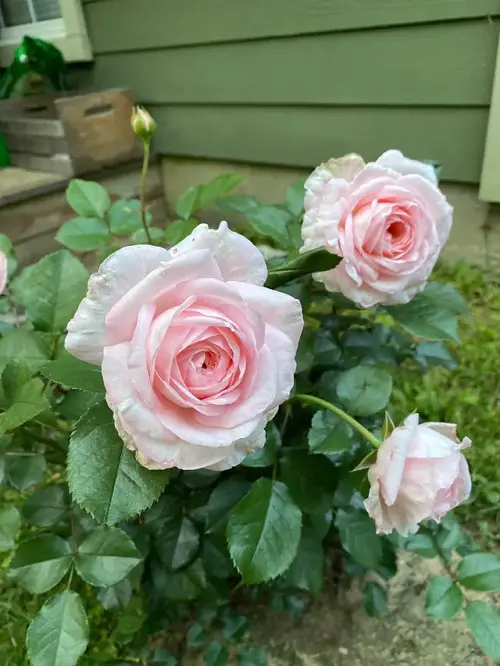
To nurture vibrant and lush roses in your garden, you should follow these comprehensive steps.
1. Choose the Right Location
- Select a location that receives at least 6-8 hours of direct sunlight per day.
- Make sure there is good air circulation around the plants to prevent fungal diseases.
2. Planting
- Plant roses in well-drained soil with good organic content.
- The planting hole should be about twice the width of the root ball and deep enough to accommodate the roots without crowding them.
- Space the rose bushes according to their mature size. Plant them 2-4 feet apart to allow proper growth and air circulation.
3. Watering
- Water deeply and consistently. Roses generally need about 1-2 inches of water per week, either through rain or irrigation.
- You should water at the base of the plant to keep the foliage dry and prevent diseases.
- Go for a soaker hose or drip irrigation to water slowly and deeply.
How To Water Plants + 5 Watering Mistakes You’re Doing
4. Fertilizing
- Fertilize roses with a balanced, slow-release fertilizer when new growth begins. And once again in late spring or early summer.
- You should follow the recommended dosage on the fertilizer package and avoid over-fertilizing. This will help you avoid excessive foliage growth at the expense of blooms.
5. Pest and Disease Control
- Regularly inspect your roses for signs of pests (like aphids, Japanese beetles, or spider mites) and diseases (such as black spot or powdery mildew).
- You can use organic or chemical treatments as needed but follow the instructions carefully.
- Promote healthy plants through proper watering, pruning, and fertilization to reduce the risk of diseases.
6. Winter Protection
- In cold climates, protect your rose bushes by mulching heavily around the base and covering them with burlap or rose cones to prevent winter damage.
7. Support
- Depending on the rose variety, you should provide support for the canes to prevent them from drooping or breaking, especially for climbing roses.
By following these steps on How to take care of roses the right way, you can enjoy beautiful and healthy rose bushes in your garden. You should know that different rose varieties may have specific care requirements, so research about them.
Rose Care Tips
Here are some essential Rose care tips for keeping your roses healthy and thriving.
1. Selecting the Perfect Rose Variety

The very first and absolutely pivotal step in successful rose care centers around selecting a rose variety perfectly attuned to your local climate and growing conditions.
There are many types of Roses and all of these require different temperatures. And their unique set of needs.
For example, in regions with cooler climates, hardy varieties like ‘Knock Out’ roses or ‘Canadian Explorer’ roses have earned their stripes as reliable choices. But in homes in warmer and more arid areas, ‘Sunblaze’ or ‘Double Delight’ roses will often prove to be standout selections.
2. Pay Attention to Rose-Specific Needs
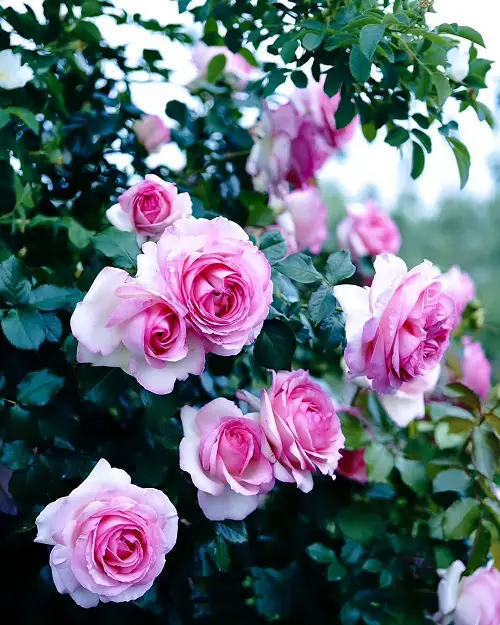
Understanding and catering to the unique requirements of your chosen rose variety is absolutely crucial.
These roses have their own preferences when it comes to factors like temperature, how much sunlight they crave, humidity levels, when and how much to water, and the type of soil they thrive in – and these factors play a substantial role in their overall health.
So, you should conduct thorough research before you even put the first seedling in the ground. Make sure that your roses get the tailored care and attention they truly deserve.
3. Do Not Skip Sunlight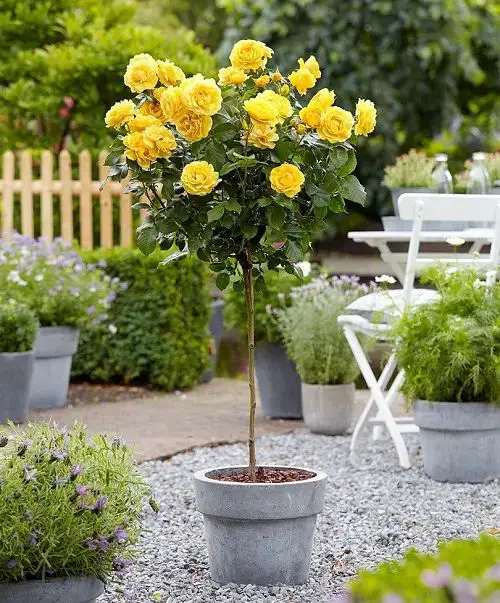
Don’t know How much sunlight do roses need? You should! Roses flourish when they receive at least six hours of direct sunlight daily, promoting vigorous and colorful blooms. Roses light requirements also vary with the variety you’re growing.
While most rose varieties prefer sunny locations, some, like David Austin, Grace, and Lady of Shallots can flourish even in partial shade. So choose the spot and then go for the variety as per the sunlight that it receives.
4. Maintaining Optimal Soil pH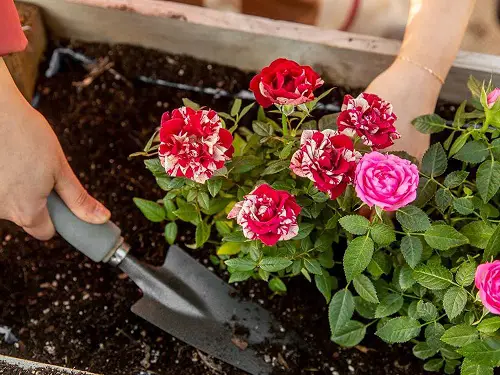
How to take care of roses plants? With the proper potting medium, of course! Roses generally thrive in slightly acidic to rich neutral soil.
Extreme soil acidity or alkalinity can hinder nutrient absorption and lead to issues such as chlorosis. You should go for a well-balanced soil mix of clay and sand. Also, organic matter is key.
Here’s the only rose mix you’ll ever need. It will suit over 95% of rose varieties.
- 2 parts loamy soil or topsoil
- 1 part well-rotted compost or organic matter
- A handful of perlite or vermiculite per part of the soil
- Bone meal (follow package instructions for the recommended amount based on the size of the planting hole)
Here is How to Change Your Soil pH
5. Strategic Rose Watering
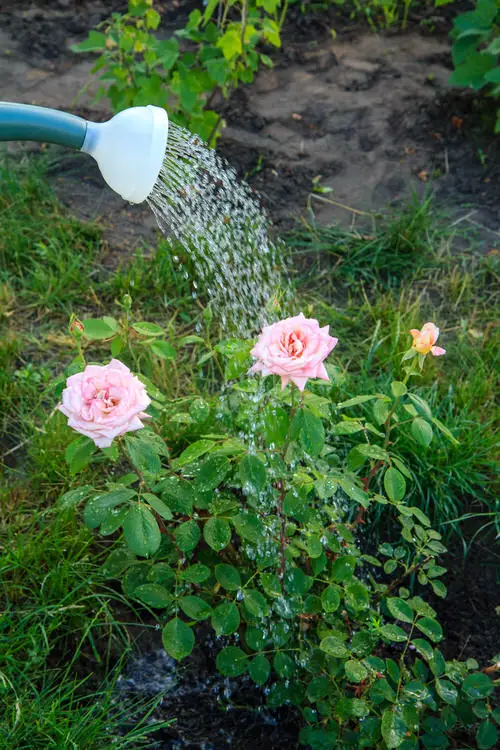
Roses have a penchant for water and require deep watering two to three times per week during the summer and once a week during other seasons. However, you need to AVOID waterlogged conditions, as roses dislike standing in excessively wet soil.
Watering roses correctly is essential for their health and blooming. Here’s a step-by-step guide on how to do it the right way.
- Water at the Base: Always aim to water the soil around the base of the rose plants rather than wetting the foliage, as it can promote fungal diseases.
- Deep and Infrequent: Give your roses a good, deep soak rather than shallow, frequent watering. It will encourage the roots to grow deeper into the soil. So water deeply to a depth of at least 12 inches.
- Morning is Ideal: The best time to water your roses is in the early morning. This allows the foliage to dry out during the day, reducing the risk of disease.
- Container Roses: If you have potted roses, water them when the top inch of soil feels dry to the touch. Make sure the pot has drainage holes to prevent waterlogging.
6. Guarding Against Root Competition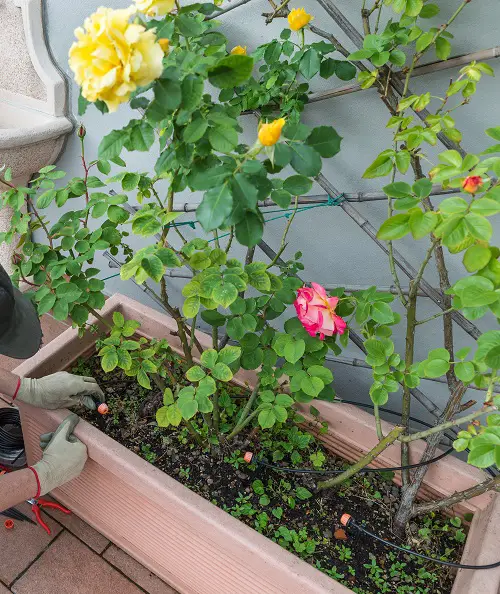
Wondering, How do you care for roses? Focus on where you plant these! You need to steer clear of planting roses in close proximity to trees and shrubs, such as maples and oaks, with extensive root systems. And why? Such plants compete with your roses for water and nutrients, potentially weakening your rose plants.
On the other hand, companions like lavender and marigolds will not only complement the aesthetics of your rose garden but also harmonize well with their root systems.
7. Harnessing the Benefits of Mulch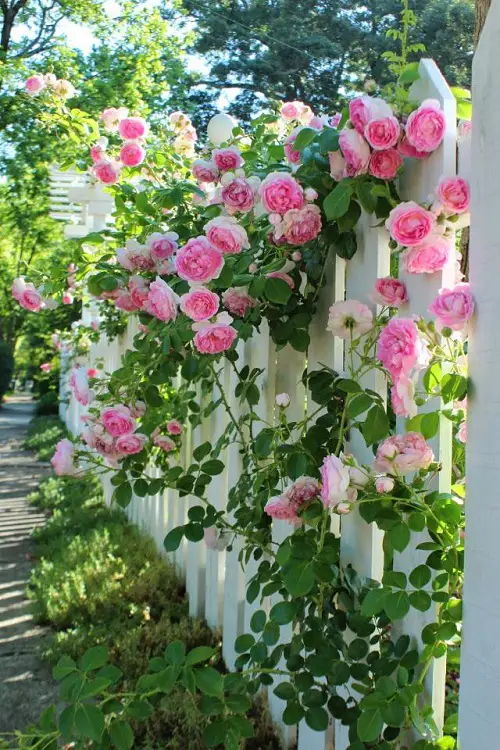
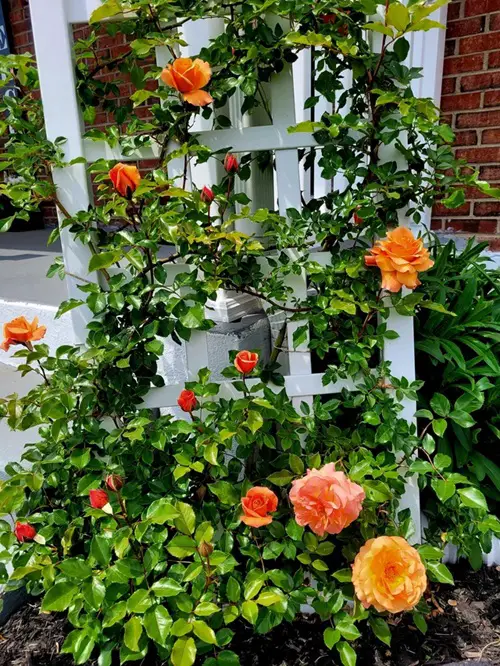
You should apply a generous 2-4 inch layer of mulch around your rose plants as it has a ton of advantages!
For starters, mulch conserves water by reducing evaporation, enriches the soil, and maintains soil temperature. The layer will also insulate the roots during winter, and act as a natural barrier against pests and weeds, boosting your Rose plants care routine!
8. Energizing Growth with Epsom Salt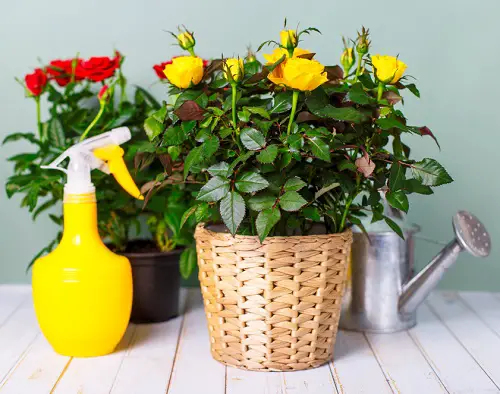
For better growth, use Epsom salt. Just create a mixture of Epsom salt and water and apply it to your roses at the onset of the growing season.
This simple remedy will have huge benefits and increase the health and vibrancy of your rose plants. This is how to create the mixture
- Carefully measure out one tablespoon of Epsom salt.
- In your chosen container, combine one tablespoon of Epsom salt with a gallon of water. Stir thoroughly to dissolve the salt completely, creating a well-mixed solution.
Timing is key. Apply this Epsom salt solution to your roses at the beginning of the growing season. This is when your roses will benefit most from the boost in nutrients.
Epsom Salt Uses In Garden That’ll Amaze You
9. Pruning for Shape and Vigor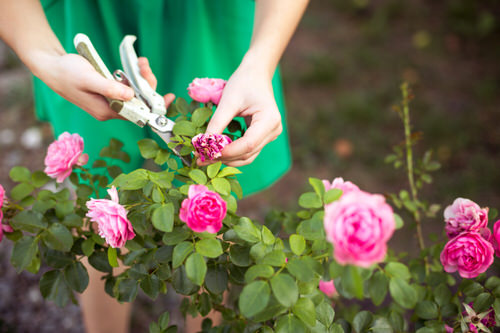
Don’t underestimate the power of pruning in nurturing your rose garden’s vitality and aesthetics. Regular pruning is a skillful practice that plays a pivotal role in the Care for rose bushes and the well-being of your rose plants.
To prune roses effectively, wait until late winter or early spring, just before new growth begins. You should start by removing dead or diseased canes at the base. Then, thin out crowded canes. Make clean cuts above outward-facing buds to shape your rose bush.
Finally, trim the overall height by about one-third.



Very creative.